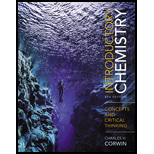
Concept explainers
(a)
Interpretation:
The mass in grams of given solidis to be calculated.
Concept introduction:
The density is defined as the ratio of mass of a body to its volume. For solid bodies densities are usually expressed in the units of grams per cubic centimeter, for liquids in the units of grams per milliliter and for gases in units of grams per liter.
(b)
Interpretation:
The mass in grams of given solid is to be calculated.
Concept introduction:
The density is defined as the ratio of mass of a body to its volume. For solid bodies densities are usually expressed in the units of grams per cubic centimeter, for liquids in the units of grams per milliliter and for gases in units of grams per liter.
Want to see the full answer?
Check out a sample textbook solution
Chapter 2 Solutions
Introductory Chemistry: Concepts and Critical Thinking Plus MasteringChemistry with eText -- Access Card Package
- Which of the following is a chemical property of Sodium?A.melts at 60°CB.soft solid C.density of 11.4 g/mL D.Reacts violently with waterarrow_forwardWhich of the following is a homogeneous mixture? a) water and sand b) water and salt c) water and cooking oil d) a hard-boiled eggarrow_forward1.17 A solid white substance A is heated strongly in the absence ofair. It decomposes to form a new white substance B and a gas C.The gas has exactly the same properties as the product obtainedwhen carbon is burned in an excess of oxygen. Basedon these observations, can we determine whether solids Aand B and gas C are elements or compounds?arrow_forward
- Which of the following figures represents (a) a pure element,(b) a mixture of two elements, (c) a pure compound, (d) amixture of an element and a compound? (More than onepicture might fit each description.)arrow_forwardWhat is the mass of a cylinder of lead with a radius of 1 centimeter and a height of 3 centimeters, given that the density of lead is 11.4 (g)/(cm^(3))?arrow_forwardWhat is the minimum mass of magnetite Fe3O4 , a iron ore, from which 1.0kg of pure iron could be extracted? Be sure your answer has a unit symbol, if necessary, and is rounded to the correct number of significant digits.arrow_forward
- The density of ethylene glycol (anti-freeze) is 1114 kg/m3. How much mass (in kilograms) of this substance is contained in a can (cylinder) of diameter 15 cm and height 25 cm? (The volume of a cylinder is).arrow_forwardThe radius of a copper (Cu) atom is roughly 1.3x10−10 m. How many times can you divide evenly a 223.3−cm long piece of copper wire until it is reduced to two separate copper atoms? (Assume there are appropriate tools for this procedure and that copper atoms are lined up in a straight line, in contact with each other. Round off your answer to an integer.)arrow_forwardWhat is the volume, in cubic centimeters (cm^3) of 1.00 kilograms of gold?arrow_forward
- The diagram on the left represents the result of a process. Which of the diagrams [(i) to (iii)]could represent the starting material if the process were physical, and which could represent the starting material if the change were chemical?arrow_forwardWhich of the following particulate illustrations represent pure substances and which represent mixtures?arrow_forwardAt 25 C, the density of water is 0.997 g/cm3, whereas the density of ice at 10 C is 0.917 g/cm3. (a) If a soft-drink can (volume = 250. mL) is filled completely with pure water at 25 C and then frozen at - 10 C, what volume does the ice occupy? (b) Can the ice be contained within the can?arrow_forward
 Chemistry & Chemical ReactivityChemistryISBN:9781337399074Author:John C. Kotz, Paul M. Treichel, John Townsend, David TreichelPublisher:Cengage Learning
Chemistry & Chemical ReactivityChemistryISBN:9781337399074Author:John C. Kotz, Paul M. Treichel, John Townsend, David TreichelPublisher:Cengage Learning World of Chemistry, 3rd editionChemistryISBN:9781133109655Author:Steven S. Zumdahl, Susan L. Zumdahl, Donald J. DeCostePublisher:Brooks / Cole / Cengage Learning
World of Chemistry, 3rd editionChemistryISBN:9781133109655Author:Steven S. Zumdahl, Susan L. Zumdahl, Donald J. DeCostePublisher:Brooks / Cole / Cengage Learning Introductory Chemistry: An Active Learning Approa...ChemistryISBN:9781305079250Author:Mark S. Cracolice, Ed PetersPublisher:Cengage Learning
Introductory Chemistry: An Active Learning Approa...ChemistryISBN:9781305079250Author:Mark S. Cracolice, Ed PetersPublisher:Cengage Learning- Chemistry: Matter and ChangeChemistryISBN:9780078746376Author:Dinah Zike, Laurel Dingrando, Nicholas Hainen, Cheryl WistromPublisher:Glencoe/McGraw-Hill School Pub Co
 General, Organic, and Biological ChemistryChemistryISBN:9781285853918Author:H. Stephen StokerPublisher:Cengage Learning
General, Organic, and Biological ChemistryChemistryISBN:9781285853918Author:H. Stephen StokerPublisher:Cengage Learning Introduction to General, Organic and BiochemistryChemistryISBN:9781285869759Author:Frederick A. Bettelheim, William H. Brown, Mary K. Campbell, Shawn O. Farrell, Omar TorresPublisher:Cengage Learning
Introduction to General, Organic and BiochemistryChemistryISBN:9781285869759Author:Frederick A. Bettelheim, William H. Brown, Mary K. Campbell, Shawn O. Farrell, Omar TorresPublisher:Cengage Learning





